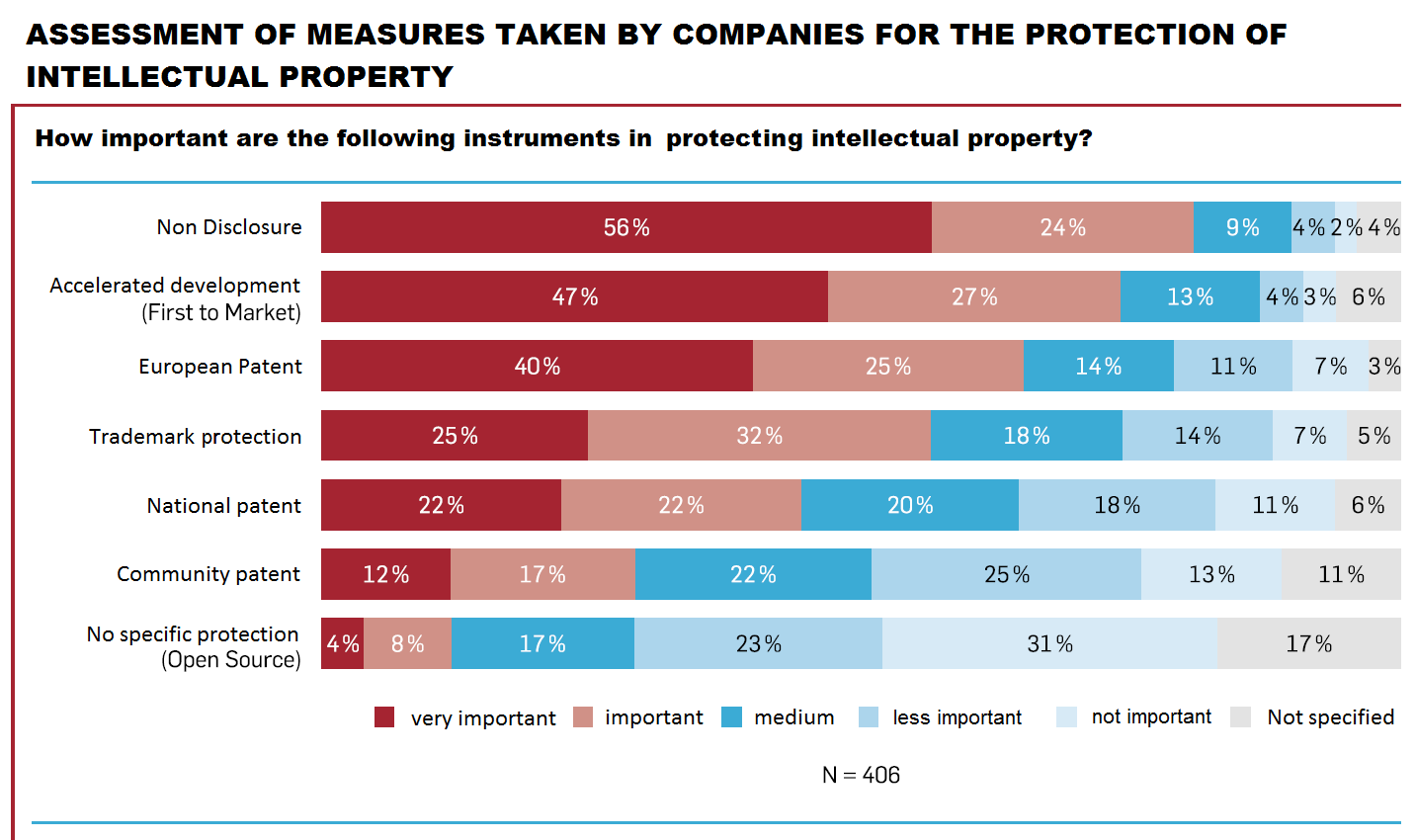Intellectual property: IP
Are knowledge transfer and the protection of intellectual property mutually exclusive
No. Both the protection of intellectual property and knowledge transfer are ultimately aimed at commercialisation. In the case of knowledge transfer, the focus is on the exchange of knowledge in order to create economic added value. Ideas, technologies or innovations protected by intellectual property rights[1] are usually commercialised at a later point in time. The protection of IP and knowledge transfer are thus complementary approaches that contribute to the same goal (cf. Intellectual Property, Europäische Kommission, English)
Intellectual property rights are very important for innovation and creativity – who would bother with years-long development projects when copying is much cheaper? The EU Commission has been implementing a comprehensive IPR strategy since 2011 as part of its Innovation Union.
The European IPR strategy also seeks to meet the challenges of modern media consumption (such as the internet) with regard to issues of IP. The idea is to bring about a new balance between ensuring that inventions and innovations are adequately remunerated on the one hand and promoting the widest possible access to products and services on the other.
The activities of the European Commission include:
- Support in IPR matters (secrecy, patents), especially for SMEs
- Encouraging trading partners to implement IPR rules
- Monitoring the Member States’ patent and trademark legislation
- Developing a unitary patent protection system for Europe and taking measures to improve patent exploitation
- Improving the use of standards through simplified IPR licensing processes
- Implementing harmonised industrial design protection laws and a proposal to harmonise the protection of trade secrets
- Investigating the possibility of establishing geographical indication protection for non-agricultural products
- Efforts to enforce intellectual property rights
- Launching campaigns against product piracy and counterfeiting
(cf. Intellectual Property, Europäische Kommission, English)
Innovations are of great importance for growth and employment and involve social challenges. To promote this, we need an investment-friendly regulatory framework. The Working Document "Better Regulations for Innovation-Driven Investment at EU-Level", which was published by the Commission in 2016, stresses the importance of a high quality and cost-effective regulatory framework for intellectual property and introduces a number of specific proposals and initiatives.
In addition to public disclosure (publications, patents etc.) and protection (e.g. patents, design protection), companies use a variety of other means to protect themselves against counterfeiting. An impact monitoring survey carried out by the FFG in 2013 showed that, according to Austrian companies, secrecy and accelerated development are the most important tools for the protection of intellectual property. 80% of the 406 companies surveyed stated that secrecy is important (24%) or very important (56%) for the protection of their intellectual property.
Being the first company to launch a technology appears to be an attractive strategy for 74% of companies. Patents seem less important (44%) for the companies surveyed.

Source: Impact monitoring 2013: Special IPR evaluation, SME research [See: Impact monitoring of FFG funding]
| very important | important | neutral | less important | unimportant | not specified | |
|---|---|---|---|---|---|---|
| Secrecy | 56% | 24% | 9% | 4% | 2% | 4% |
| Accelerated development (first to market) | 47% | 27% | 13% | 4% | 3% | 6% |
| European patent | 40% | 25% | 14% | 11% | 7% | 3% |
| Trademark protection | 25% | 32% | 18% | 14% | 7% | 5% |
| National patent | 22% | 22% | 20% | 18% | 11% | 6% |
| Joint patent | 12% | 17% | 22% | 25% | 13% | 11% |
| No explicit protection (open source) | 4% | 8% | 17% | 23% | 31% | 17% |
Patenting activities of public research organisations and universities together with license income
The Knowledge Transfer Study 2010 – 2012 shows the following picture for the patent situation of public research institutions and patent exploitation in Austria:
Austria is below the EU average in terms of patent grants as well as license agreements and licensing income. While the EU average was 4.5 patent grants per 1,000 researchers, Austria produced only 2.9 patent grants per 1,000 researchers in 2011.
Furthermore, with 1.6 license agreements per 1,000 researchers, Austria lagged behind the EU average of 6.5. Licensing income per 1,000 researchers in Austria was also low at 38,000 euros, compared with the EU average of 399,000 euros.

Source: MERIT, European Knowledge Transfer Indicator Survey 2011 and 2012 [see: Knowledge Transfer Study 2010 – 2012, 2012, English, 385 pp]
| Countra | License revenues per 1000 researchers |
|---|---|
| CZ | 3130 |
| IL | 2081 |
| BE | 2035 |
| UK | 970 |
| FR | 675 |
| CH | 596 |
| DK | 462 |
| DE | 400 |
| EU | 399 |
| IE | 351 |
| NL | 341 |
| NO | 291 |
| ES | 89 |
| IT | 61 |
| PT | 53 |
| AT | 38 |
| FI | 22 |
| BG | 7 |
| HU | 5 |
| SE | 1 |
| LV | |
| SI | |
| HR |
As the Austrian ERA Roadmap shows, Austria has taken great efforts in recent years to catch up and to promote the exploitation of publicly funded research [cf. https://era.gv.at/object/document/2581]
This text is an excerpt from the NCP-IP brochure "Europäisches Wissen Transferieren ” (Transferring European Knowledge).








